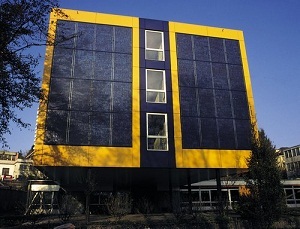Building a new solar infrastructure
 The Richmond Times-Dispatch reported on Aug. 15 that United States Green Energy Corp. installed a building-integrated photovoltaic (BIPV) roof on Colonial Orthopaedics’s Colonial Heights, Virginia, building. While it’s not surprising that the practice would look to photovoltaics (PVs) to help reduce its long-term electricity costs, especially with net-metering laws in Virginia, what is surprising is that the solar-powered roof was lifted into place in just a few pieces.
The Richmond Times-Dispatch reported on Aug. 15 that United States Green Energy Corp. installed a building-integrated photovoltaic (BIPV) roof on Colonial Orthopaedics’s Colonial Heights, Virginia, building. While it’s not surprising that the practice would look to photovoltaics (PVs) to help reduce its long-term electricity costs, especially with net-metering laws in Virginia, what is surprising is that the solar-powered roof was lifted into place in just a few pieces.
The focus of United States Green Energy, company partner Robert Bennett told Clean Energy Authority, is to develop truly BIPV materials to help reduce the costs of integrating solar power into buildings. The company is new and doesn’t yet have a website. Bennett explained that the company now is focused on developing BIPV products based on existing construction and manufacturing standards.
This includes making sure that PV system mounts are 16 inches on center, like the studs in some walls or trusses in roofs. Bennett explained that after the company has developed these building materials and is ready for a national rollout, it will start a site.
The system United States Green Energy installed at Colonial Orthopaedic’s building is a 70 kilowatt (kW) array that Bennett said cost about $75 per square foot to install, with an overall cost of $500,000. According to Bennett, the company will soon produce BIPV roofing materials ready for installation at a cost of $45 per square foot. A figure, he contended, was as much as some Energy Star roofing materials cost to install.
Ultimately, Bennett said Green Energy “is in the building industry, not the solar industry.” He explained that it mean the company is focused on creating true BIPV products that replace existing parts of building, like exterior wall shingles or siding and roofs. The company also is developing BIPV systems that can be installed and connected by a general contractor. When the company is ready for its national rollout, he said, its market will be building material distributors, not solar distributors. The system at Colonial Orthopaedic is a start, and the BIPV firm has four more in the works.
John Wiseman, practice administrator for Colonial Orthopaedics, told Clean Energy Authority the system at its 10,000 foot facility is capable of providing more than 100 percent of the clinic’s electricity needs during summer months and that it will supply about half its needs in the winter months. Wiseman also said the system was capable of handling spikes in energy use, like when the facility’s X-ray machine is used.
Any excess generation produced during the day will be credited toward future electricity bills under Virginia’s net-metering rules. But Wiseman doesn’t expect the system to eliminate the clinic’s energy bills. He explained that the building also houses Colonial Orthopaedics’ data center, which remains on overnight. The health care organization has four clinics in Virginia and based on the results of the PV system at this Colonial Heights facility, the group may choose to add PV to its other clinics, Wiseman said.
Bennett told the Dispatch that the PV should pay for itself, in terms of reduced grid-electricity use, within about five years.



